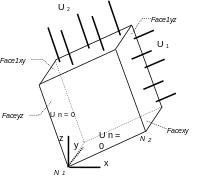1. Reference problem#
1.1. Geometry#
It is an 8-node cube, where two faces have zero normal displacement, and the two opposite faces have an imposed normal displacement, different from each other by a factor of 2.
The cube has a side of \(1\mathrm{mm}\). The test cases are composed of a charge, followed by a discharge. In modeling A, the cube is oriented according to the coordinate system \(\mathit{Oxyz}\). In model B, it is rotated \(30°\) by around the \(\mathrm{Oy}\) axis.

Modeling A
B Modeling

\({U}_{2}\mathrm{=}{\mathrm{2.U}}_{1}\)
1.2. Material properties#
To test the evolution of mechanical characteristics irreversibly with temperature, a decreasing temperature field is applied. Some variables depend on temperature, others on drying. Finally, a non-zero desiccation shrinkage coefficient, equal to the thermal expansion coefficient, is applied to test « computer » operation. The thermal deformations will thus be equal and opposite to the deformations due to desiccation shrinkage. These dependencies only occur for purely computer checks; the mechanical characteristics can be considered to be constant.
For the usual linear mechanical characteristics:
Young’s module: |
\(E=32000\mathrm{MPa}\) |
of |
\(0°C\) to \(20°C\) |
\(E=15000\mathrm{MPa}\) |
to |
\(400°C\) (linear decay) |
|
\(E=5000\mathrm{MPa}\) |
to |
\(800°C\) (linear decay) |
|
Poisson’s ratio: |
\(\nu =0.18\) |
||
Coefficient of thermal expansion: |
\(\alpha ={10}^{-5}\) |
||
Desiccation shrinkage coefficient: |
\(\kappa ={10}^{-5}\) |
For the non-linear mechanical characteristics of the model **** BETON_DOUBLE_DP :**
Uniaxial compression strength: |
\(f\text{'}c=40N/{\mathrm{mm}}^{2}\) |
of |
\(0°C\) to \(400°C\) |
f’c = 15 N/mm^2 |
to |
\(800°C\) (linear decay) |
|
Uniaxial tensile strength: |
\(f\text{'}t=4N/{\mathrm{mm}}^{2}\) |
of |
\(0°C\) to \(400°C\) |
\(f\text{'}t=1.5N/{\mathrm{mm}}^{2}\) |
to |
\(800°C\) (linear decay) |
|
Ratio of resistances in biaxial compression/uniaxial compression: |
\(\beta \mathrm{=}1.16\) |
||
Breakdown energy in compression: |
\(\mathit{Gc}\mathrm{=}10\mathit{Nmm}\mathrm{/}{\mathit{mm}}^{2}\) |
||
Tensile breaking energy: |
\(\text{Gt}\mathrm{=}0.1\mathit{Nmm}\mathrm{/}{\mathit{mm}}^{2}\) |
||
Ratio of the elastic limit to the resistance in uniaxial compression: |
30% |
1.3. Boundary conditions and mechanical loads#
Temperature field decreasing from \(20°C\) to \(0°C\). |
|
Underside of the cube (\(\mathrm{facexy}\)): |
blocked next \(\mathrm{oz}\). |
Top side of the cube (\(\mathrm{face1xy}\)): |
forced displacement \(0.30\mathrm{mm}\) followed by a \(0.1\mathrm{mm}\) dump |
Left side of the cube (\(\mathrm{faceyz}\)): |
blocked next \(\mathrm{ox}\). |
Right side of the cube (\(\mathrm{face1yz}\)): |
forced displacement \(0.15\mathrm{mm}\) followed by a \(0.05\mathrm{mm}\) dump |
Lower front nodes (\({N}_{1}\), \({N}_{2}\)): |
stuck next \(\mathrm{oy}\) (Suppression of solid body movements). |